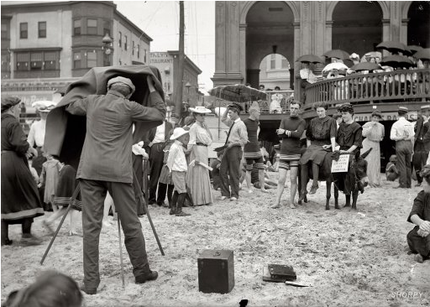History of Atlantic City

History of Atlantic City
http://www.acfpl.org/
Written by: Atlantic City Free Public Library
Long before Atlantic City was founded, the island where it would be developed, thick with woods and lined with dunes, was the summer home of the Lenni Lenape Indians, an Algonquian-speaking people. These original summer residents named the island Absegami, meaning “little water”, a term for the bay denoting that the opposite shore was in sight. Over time the name was transformed into the present-day Absecon Island. Early colonial settlers in South Jersey largely ignored the island because it could only be reached by boat. While the exact date of the first permanent settlement has never been determined, it is generally agreed that Jeremiah Leeds was the first to build and occupy a year-round residence on the island, building his home in 1783.
By 1850, the potential attraction of the island’s cool breezes and beaches was recognized and the idea for developing a resort was first promoted by Dr. Jonathan Pitney, a local physician. With transportation the key to development, Dr. Pitney, along with a group of businessmen, secured a railroad charter in 1852. Two years later, construction of the Camden-Atlantic rail line was completed at a cost of a little over $1.2 million. A civil engineer from Philadelphia, Richard B. Osborne, designed the city layout and proposed the name Atlantic City.
In March of 1854, the city was incorporated and eighteen voters elected the first mayor, Chalkey S. Leeds. On July 1, 1854, the first public train left Camden for Atlantic City, arriving two-and-a-half hours later, to signal the opening chapter in the resort’s rich and colorful history.
Atlantic City’s proximity to major population centers, coupled with convenient, inexpensive train access, allowed thousands to flee hot cities and enjoy summer pleasures at the cool seashore. The city grew rapidly and offered lodging, dining, entertainment and amusements for all ages, tastes and incomes. Attractions such as the Boardwalk, amusement piers, floor shows and beauty pageants drew throngs of visitors, including many famous people, throughout the years.
From the 1880s to 1940s, Atlantic City was a major vacation resort. In the 1920s it was considered the premier tryout town for theatrical productions headed for Broadway and beyond. Beginning in the 1930s and continuing in the next three decades, Kentucky Avenue was renown for its nightlife, with Club Harlem and other venues attracting the best talent and biggest stars from the world of jazz. During World War II, the city offered much more than entertainment distractions, as it served as a training site for military recruits and a recovery and rehabilitation center for wounded soldiers.
In the 1950s, as air travel to vacation spots in Florida and the Caribbean became more widely available, Atlantic City’s popularity as a resort destination began to decline. By the 1960s, the city was beset with the economic and social problems common to many urban centers at the time. With an economy entirely dependent on tourists who were now shunning the decaying resort, the city reached its nadir.
In 1976, the “Atlantic City Gamble ” was launched when New Jersey voters approved a referendum legalizing gambling in Atlantic City, but not elsewhere in the state. While many critics questioned the wisdom of using legalized gambling as a tool for urban development, many others were convinced casinos would provide the resources needed to rebuild the city and its tourist trade. The first casino, Resorts International, opened in 1978, and no one could have predicted the rapid growth of the gaming industry in Atlantic City, or the tremendous impact it would have on the city, the region and the state. By 1988, a dozen casinos were open and the number of annual visitors had grown from 700,000 in 1978, to over 33 million. By the year 2000, the city’s tax base had skyrocketed to more than $6.7 billion, up from $316 million in 1976. The positive impact on Atlantic City residents can be seen in revitalized neighborhoods, new housing projects and public service facilities and in economic, social and cultural programs.
Atlantic City Timeline
1783 Jeremiah Leeds establishes first permanent settlement on Absecon Island
March 19, 1852 Railroad charter granted for the Camden & Atlantic Company
January 15, 1853 Name “Atlantic City” adopted by City founders May 1, 1854 First mayor, Chalkey S. Leeds, elected July 1, 1854 First train to Atlantic City arrives from Camden January 15, 1857 Absecon Lighthouse opens June 26, 1870 First Boardwalk opens March 15, 1915 Jitney line established September 7, 1921 First Miss America, Margaret Gorman, crowned May 31, 1929 Atlantic City Convention Hall dedicated September 14, 1944 Hurricane destroys more than half of the Boardwalk November 2, 1976 New Jersey voters approve casino gambling referendum May 26, 1978 First casino, Resorts International, opens March 13, 1984 City’s first African American mayor, James L. Usry, elected November 14, 1994 New Atlantic City High School opens May 1, 1997 New Atlantic City Convention Center opens September 21, 2000 Groundbreaking for The Borgata , first new casino since 1990 July 31, 2001 Atlantic City-Brigantine Connector tunnel opens October 10, 2001 Rededication of historic Atlantic City Convention Hall, renamed Boardwalk Hall 2004 Atlantic City celebrates 150th birthday
2005 New retail stores, restaurants and clubs open, including The Walk
September 30, 2006 Bader Field closes November 11, 2006 Sands Casino closes.

